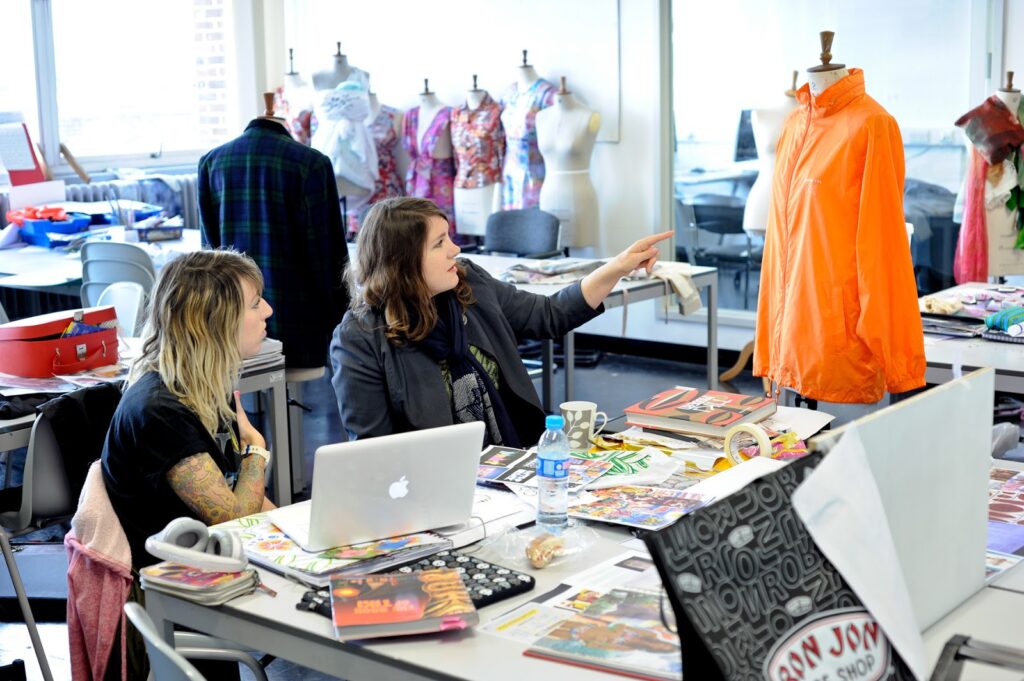Introduction
The fashion industry is one of the most exciting and dynamic sectors in the global economy. From designing garments to managing fashion brands, there are countless career opportunities for individuals with a passion for creativity, design, and business. Whether you’re interested in high fashion, retail, or the behind-the-scenes operations of a fashion brand, the fashion industry offers something for everyone.
As we enter 2025, the demand for talented professionals in the fashion world continues to grow. In this article, we will explore various fashion industry jobs, the skills required for success, salary expectations, and the job outlook for those aspiring to join the fashion world. We will also discuss the latest trends in fashion jobs and the paths you can take to build a successful career in this fast-paced and ever-evolving industry.
Types of Fashion Industry Jobs
The fashion industry encompasses a wide range of roles that require different skill sets and expertise. Below are some of the most popular job categories within the fashion industry:
1. Fashion Designer
Fashion designers are at the heart of the fashion industry, creating new clothing and accessories collections each season. They combine creativity and technical skill to design garments that reflect current trends and meet the needs of their target audience.
Key Responsibilities:
- Designing clothing and accessories
- Researching trends and consumer preferences
- Creating sketches and prototypes
- Selecting fabrics and materials
- Collaborating with manufacturers and suppliers
Salary Range: $45,000 – $100,000 annually.

2. Fashion Buyer
Fashion buyers are responsible for selecting the clothing and accessories that will be sold in retail stores. They must have a strong understanding of market trends, consumer preferences, and the retail industry to make informed purchasing decisions that will appeal to their customers.
Key Responsibilities:
- Researching fashion trends and forecasting future styles
- Negotiating prices with suppliers and manufacturers
- Managing inventory and stock levels
- Selecting items for retail stores based on market demand
Salary Range: $50,000 – $90,000 annually.
3. Fashion Merchandiser
Fashion merchandisers play a vital role in the fashion industry by ensuring that the right products are available at the right time and place. They manage product placement, marketing, and pricing strategies to maximize sales and profitability.
Key Responsibilities:
- Developing merchandising strategies for fashion brands
- Managing product displays and store layouts
- Analyzing sales data to optimize product placement
- Collaborating with designers and buyers to ensure product availability
Salary Range: $40,000 – $75,000 annually.
4. Fashion Stylist
Fashion stylists work with individuals, celebrities, or brands to create the perfect look for photo shoots, fashion shows, or red-carpet events. They are responsible for selecting outfits, accessories, and coordinating the overall aesthetic.
Key Responsibilities:
- Selecting and styling outfits for photo shoots, events, and advertisements
- Working with photographers, models, and clients to achieve the desired look
- Collaborating with fashion designers and other professionals
- Managing clothing fittings and styling sessions
Salary Range: $35,000 – $80,000 annually.
5. Fashion Photographer
Fashion photographers capture the visual representation of fashion through photography. They work closely with designers, stylists, and models to showcase the latest collections and trends in the most captivating way.
Key Responsibilities:
- Photographing fashion collections and designs for magazines, websites, and advertisements
- Working with lighting, composition, and camera techniques
- Directing models and styling the photoshoot
- Editing and retouching photos to ensure they meet industry standards
Salary Range: $40,000 – $90,000 annually.
6. Fashion Marketing and PR Specialist
Fashion marketing and public relations (PR) specialists are responsible for promoting fashion brands, designers, and collections. They use their knowledge of media, communication, and branding to develop marketing campaigns and build relationships with fashion journalists, influencers, and customers.
Key Responsibilities:
- Creating and executing marketing campaigns for fashion brands
- Managing social media platforms and online presence
- Building relationships with media outlets, bloggers, and influencers
- Organizing events, shows, and promotions to boost brand awareness
Salary Range: $45,000 – $85,000 annually.

7. Fashion Production Manager
Fashion production managers oversee the manufacturing process of clothing and accessories. They ensure that garments are produced on time, meet quality standards, and are delivered within budget. They work closely with suppliers, manufacturers, and the design team to manage production schedules.
Key Responsibilities:
- Managing production schedules and timelines
- Coordinating with manufacturers, suppliers, and vendors
- Ensuring product quality and compliance with regulations
- Managing budgets and overseeing cost control measures
Salary Range: $55,000 – $100,000 annually.
8. Fashion Illustrator
Fashion illustrators create visual representations of clothing and fashion designs through sketches and drawings. They work closely with designers to bring their concepts to life and communicate ideas for new collections.
Key Responsibilities:
- Drawing and illustrating fashion designs
- Working with fashion designers to create visual concepts for collections
- Creating detailed sketches for garments, accessories, and fashion shows
- Using digital tools and software to enhance illustrations
Salary Range: $40,000 – $70,000 annually.
Skills and Qualifications for Fashion Industry Jobs
To succeed in the fashion industry, a combination of creativity, technical knowledge, and business acumen is essential. Here are some of the key skills and qualifications needed for various fashion industry roles:
1. Creativity
Fashion is all about innovation, and having a creative mindset is crucial for any fashion-related job. Whether you’re designing new clothing, styling a shoot, or creating marketing campaigns, creativity is essential to stand out in the competitive fashion world.
2. Communication Skills
Whether you’re working with a team, clients, or suppliers, strong communication skills are essential. Fashion professionals need to clearly express ideas, collaborate with others, and negotiate with manufacturers, clients, and media outlets.
3. Attention to Detail
Fashion is a detail-oriented industry where precision matters. From color schemes and fabric choices to styling and photo composition, small details can make a big difference in creating the perfect final product.
4. Technical Skills
Many roles in fashion require specific technical skills. For example, fashion designers need to be proficient in design software such as Adobe Illustrator, while production managers must understand the manufacturing process and supply chain logistics.
5. Business Acumen
Fashion professionals, especially those in marketing, retail, or production, must possess strong business skills. Understanding market trends, financial management, and strategic planning are essential for ensuring that fashion brands succeed in a competitive market.
6. Knowledge of Fashion Trends
Staying up-to-date with the latest fashion trends and understanding consumer preferences is essential for anyone working in the fashion industry. Fashion professionals must constantly monitor the market and adapt to changing trends.
How to Get Started in Fashion Industry Jobs
1. Education and Training
Many fashion industry jobs require formal education or specialized training. Fashion design, merchandising, marketing, and production often require degrees in fashion design, fashion merchandising, or business.
2. Internships and Apprenticeships
Internships are a great way to gain hands-on experience in the fashion industry. Many fashion brands, magazines, and agencies offer internships for aspiring designers, stylists, and marketers. This provides valuable exposure to the industry and helps build a strong network.
3. Build a Portfolio
For creative roles like fashion design, styling, and photography, a strong portfolio is essential. Your portfolio should showcase your best work, including sketches, photos, or marketing materials. This is your opportunity to demonstrate your skills and creativity to potential employers.
4. Networking
Networking is key to securing fashion industry jobs. Attend fashion shows, conferences, and industry events to meet professionals, learn from industry leaders, and make connections. Social media platforms like LinkedIn and Instagram can also be valuable tools for building your network.
5. Freelance or Start Your Own Brand
For those with an entrepreneurial spirit, freelancing or starting your own fashion brand can be a rewarding path. Many successful fashion designers and stylists started by freelancing, and social media platforms have made it easier to promote your work and attract clients.
Salary Expectations in the Fashion Industry
Salaries in the fashion industry can vary widely depending on the role, experience, and location. Below is a general salary range for some common fashion industry jobs:
- Fashion Designer: $45,000 – $100,000 annually
- Fashion Buyer: $50,000 – $90,000 annually
- Fashion Merchandiser: $40,000 – $75,000 annually
- Fashion Stylist: $35,000 – $80,000 annually
- Fashion Photographer: $40,000 – $90,000 annually
- Fashion Marketing and PR Specialist: $45,000 – $85,000 annually
- Fashion Production Manager: $55,000 – $100,000 annually
- Fashion Illustrator: $40,000 – $70,000 annually
Salaries can also vary depending on the company and geographic location, with major fashion hubs like New York, Paris, and Milan typically offering higher salaries.

Trends in Fashion Industry Jobs for 2025
The fashion industry is constantly evolving, with new trends shaping the job market. In 2025, the following trends are expected to have a significant impact:
- Sustainability: As consumers demand more eco-friendly products, sustainability in fashion is becoming a key focus. Jobs related to sustainable fashion, such as eco-conscious designers and sustainable sourcing experts, will see an increase.
- Technology Integration: Fashion technology, including AI, virtual fitting rooms, and 3D printing, is transforming the industry. Fashion professionals who can leverage these technologies will be in high demand.
- E-commerce Growth: With the rise of online shopping, e-commerce roles such as digital marketing, social media management, and online merchandising are becoming essential in the fashion industry.
Conclusion
The fashion industry is a dynamic and exciting field that offers numerous career opportunities. Whether you’re interested in design, marketing, production, or styling, there is a niche for everyone in this ever-evolving sector. As the industry continues to grow and change, there will be even more opportunities for those with the right skills, creativity, and drive.
If you are passionate about fashion, developing your skills, gaining experience, and staying up-to-date with trends are key to finding success. By focusing on building a strong portfolio, networking, and leveraging educational opportunities, you can embark on a rewarding career in the fashion industry.
